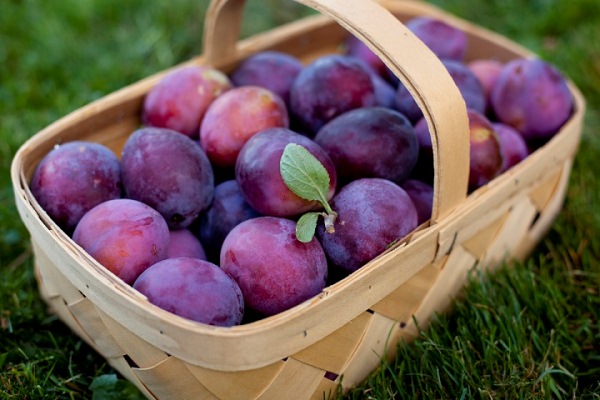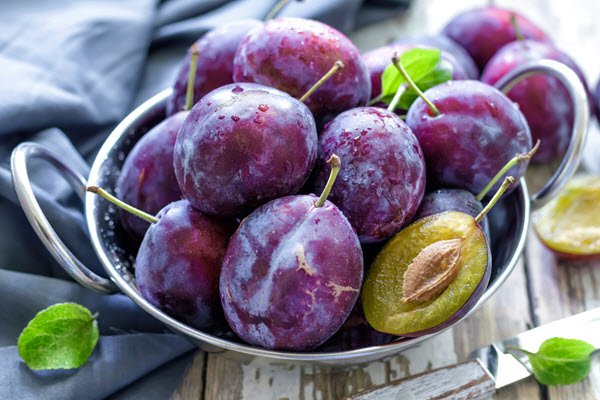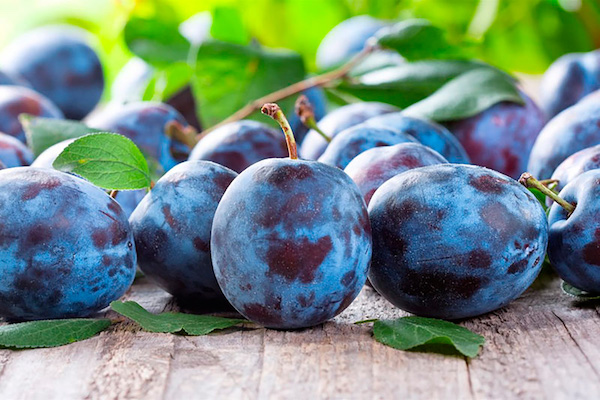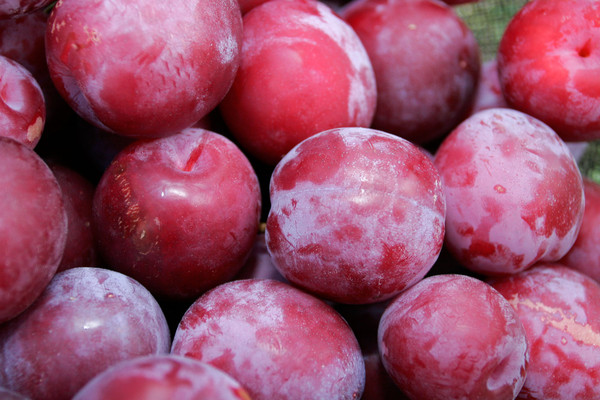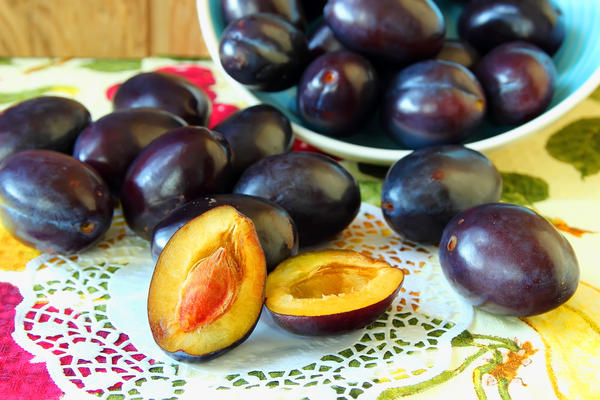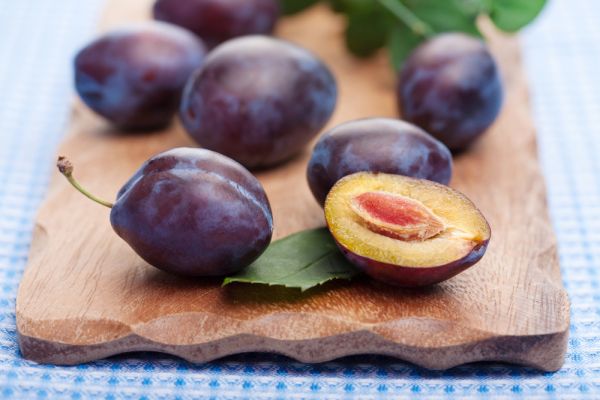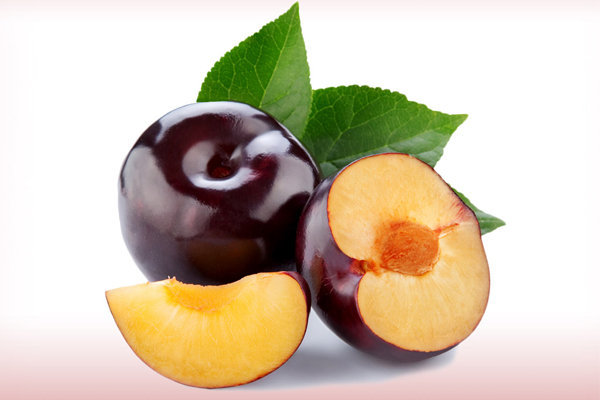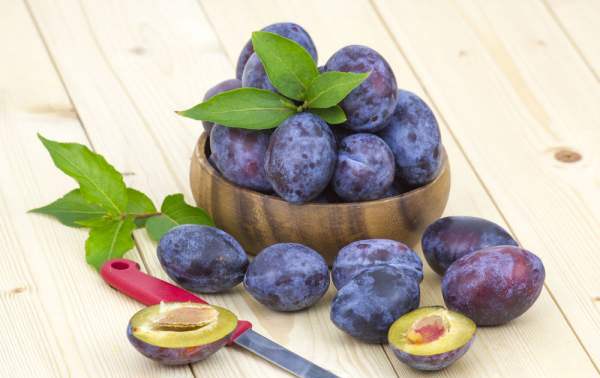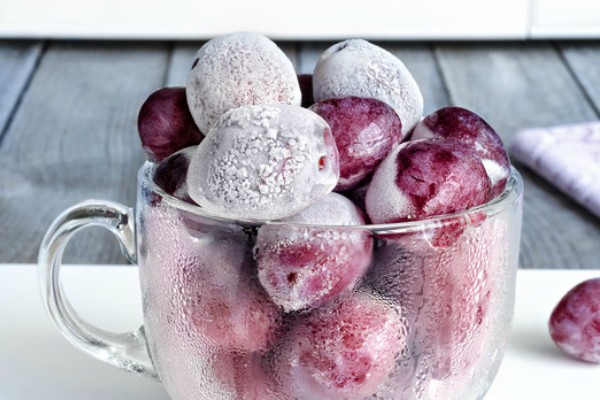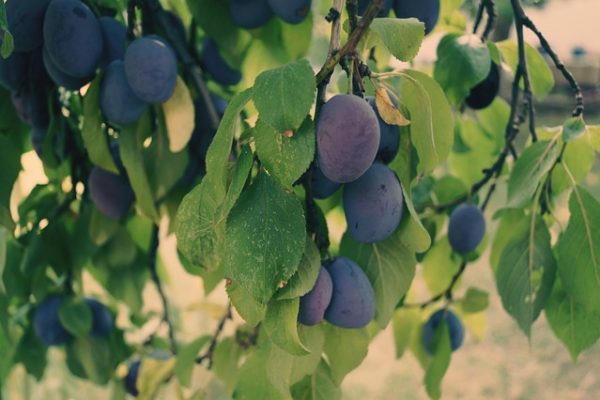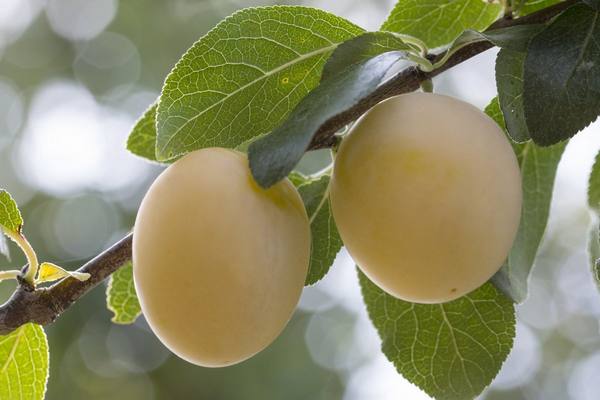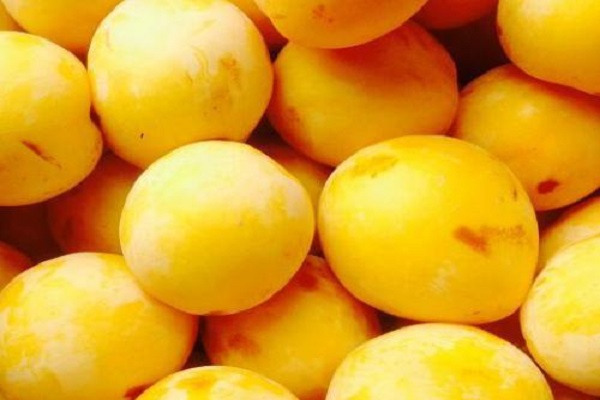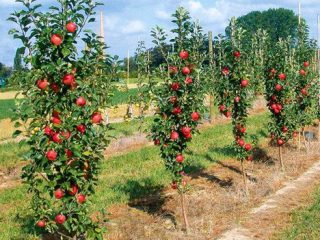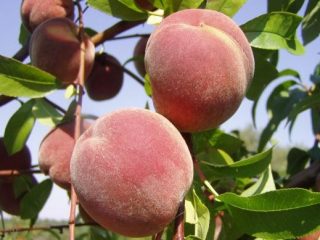Content
- 1 Is plum a berry or fruit?
- 2 What vitamins are contained in plums?
- 3 Plum: health benefits and harms
- 4 What are the benefits of plums for the human body?
- 5 Medicinal properties of plum
- 6 The undoubted benefits of plums for athletes
- 7 Is plum good for weight loss?
- 8 Benefits of dried plums
- 9 The benefits of frozen plums
- 10 Benefits of plum compote
- 11 Healing properties of plum leaves, seeds and flowers
- 12 The use of plum in cosmetology
- 13 Restrictions and contraindications for taking plums
- 14 How to choose and store correctly
- 15 Conclusion
The benefits of plums are that this product helps relieve the symptoms of many ailments, saturates the body with vitamins and improves appearance. To appreciate a plum, you need to consider all its properties.
Is plum a berry or fruit?
The fruits of the plant are very small, and colloquially they are called berries. However, they are actually fruits. By definition, berries have many seeds, but plums always have only one seed.
Plum is a tree or shrub
The main difference between trees and shrubs is height. Different varieties of plum trees can reach from 2 to 15 m. Therefore, the botanical form of the plant depends on the variety - a plum can be either a shrub or a tree.
What kind of fruit does a plum have?
The main culinary and medicinal value lies in plum fruits. What features and characteristics do they have?
Type of plum fruit
The plant is called single-seeded, and the fruits are called monodrupes. The shape of the fruits can be either round or slightly elongated, red, dark purple or yellow.
How many grams are in one plum
There are quite a few plum varieties, differing in size and weight. On average, the weight of one fruit can range from 15 to 30 g - the exact weight is determined by the variety.
What vitamins are contained in plums?
The value of the product is determined by its chemical composition and nutritional value. Small fruits contain a lot of useful substances.
Composition of plum
Every plum fruit, regardless of variety, contains:
- organic acids - folic, pantothenic, ascorbic;
- retinol;
- tocopherol;
- riboflavin;
- cellulose;
- ash and starch;
- a large amount of water;
- vitamin P, which strengthens blood vessels;
- vitamin C, which improves immunity;
- vitamin A, good for the eyes;
- vitamin E;
- vitamins B1 and B2, B6 and B9, B5;
- beta-carotene;
- nicotinic acid PP;
- pyridoxine;
- disaccharides;
- thiamine
Plum fruits also contain a huge amount of minerals. Namely:
- copper, potassium, iron, calcium, phosphorus;
- cobalt, iodine and chromium;
- sodium, molybdenum, sulfur and zinc;
- silicon, fluorine and nickel.
How much sugar is in plum
Fruits contain quite a lot of natural sugar - up to 3.4 g per fruit and up to 10 g per 100 g of product. The glycemic index of fresh plums is 22 units.
How many carbohydrates are in plums
Per 100 g of plum fruits there are about 11.5 g of carbohydrates, represented in total by sugars, fiber and starch.
How many calories are in plums
On average, the calorie content of plums is about 40 - 45 calories per 100 g of fruit. However, the exact indicator depends on the type of fruit.
How many calories are in blue plum
Dark blue plums are the most nutritious. The calorie content of fresh blue plums is 44 calories per 100 g, or 3 to 4 fruits.
Calorie content of red plum
Fruits with dark red skin are less nutritious, with only 41 calories per 100g.
Yellow plum calories
The nutritional value of yellow fruits is slightly higher - 42 calories in several fruits, or 100 g.
How many calories are in frozen plums?
The product, frozen for long-term storage, contains 40 calories per 100 g.
Plum: health benefits and harms
The chemical composition of all varieties of the product is approximately the same, and the body will benefit from consuming any fruit. In particular, plum:
- normalizes the functioning of the stomach and intestines;
- eliminates swelling and improves kidney function;
- strengthens resistance to viral and infectious diseases;
- has a beneficial effect on nails, hair and skin.
Benefits of black plum
Black plum is one of the best remedies for intestinal problems. Eating dark purple fruits helps normalize stomach function and eliminates constipation.
The benefits and harms of yellow plum
Fruits with yellow or almost white skin are especially beneficial for weight loss. The product removes excess fluid and harmful substances from the body. Its high fiber content helps improve metabolic processes.
Benefits of red plum
Red plum is the best product for normalizing blood pressure and strengthening blood vessels. It has a particularly good effect on the cardiac system, normalizes metabolism, and helps the liver.
What are the benefits of plums for the human body?
Not only the fruits are used for food and drinks, but also other parts of the plant—flowers, fresh and dried leaves, and bark. The benefit to the body is that the product:
- protects blood vessels and cleanses the blood of cholesterol;
- regulates water-salt balance;
- strengthens the immune system and improves memory;
- has an anti-inflammatory and wound-healing effect;
- supports healthy joints, protects vision, reduces high blood pressure;
- promotes fast metabolism.
Plum: benefits and harms for men's health
Men are much more susceptible to cardiovascular diseases than women, but the fruit will prevent the development of heart attacks and strokes, and this is its benefit.
Benefits of plums for women
For women, the benefits of plums are that the product prevents cancer, maintains health during menopause, and helps to lose extra pounds.
Can pregnant women eat plums?
During the period of bearing a child, the product saturates the body with vitamins and also helps solve the problem of constipation. True, plums during pregnancy in the 3rd trimester increase appetite - so you need to eat it with caution so as not to harm your own body and the fetus.
Is it possible to eat plums while breastfeeding?
But during lactation it is better to temporarily avoid the product - plums can cause colic in infants.
Beneficial properties of plums for children
Plum will be of great benefit to a child’s body. The fruits will help establish healthy functioning of the stomach and intestines, strengthen the child’s immunity, and protect vision and the nervous system.
The benefits and harms of plums for babies
You can introduce your baby to the product for the first time at 3-4 months of age - and give it a prune decoction or infusion. From six months you can introduce prunes and dried plum compote into the diet, from 8 months - boiled soft puree from yellow or red plums.
Puree from ordinary blue plums is allowed to be offered to a baby only after 1 year, and fresh fruit - no earlier than 2 - 3 years.
Can plums be consumed by diabetics?
Plum for type 2 diabetes is allowed in very small doses - no more than 4 - 5 pieces, and it is advisable to take a dried rather than a fresh product. The same applies to type 1 disease.
Is it possible to use plums for pancreatitis?
In case of acute inflammation of the pancreas, draining is strictly prohibited.But for pancreatitis in chronic non-acute form, you can eat 3 or 4 ripe fruits a day - the body will benefit.
Is it possible to eat plums if you have cancer?
Fresh plum fruits prevent the spread of free radicals in the body and serve as a prevention of cancer. It is also necessary to consume plums if you already have a disease - in combination with chemotherapy and drug treatment, it will contribute to recovery.
Medicinal properties of plum
The benefits of plums for the human body are expressed in its healing properties. When can it help, and how to use it?
Plum in folk medicine
Home treatment with plum will be beneficial for the following ailments:
- hypertension;
- atherosclerosis;
- kidney and liver diseases;
- thrombosis;
- colds with high fever;
- tendency to edema;
- high cholesterol.
The following recipes are popular:
- For constipation fresh plum fruits are boiled for 15 - 20 minutes, then filtered and the drink is drunk warm or cold three times a day in the amount of a glass.
- To improve peristalsis and appetite It is recommended to use plum juice - to obtain it you need to squeeze out the required amount of fresh berries along with the pulp.
The undoubted benefits of plums for athletes
Plums replenish the lack of vitamins and fluids after training. Of particular benefit is the large amount of potassium, which strengthens the heart and promotes muscle recovery.
Is plum good for weight loss?
During a diet, plums will be beneficial because they regulate metabolism. It is best to take low-calorie yellow plums for weight loss. However, the daily amount should not exceed 5 – 6 fruits.
Benefits of dried plums
Prunes, or dried plums, contain almost the same vitamins and elements as fresh fruit. Therefore, regular consumption of prunes increases the tone of the body, swelling and excess salts go away, and the immune system is strengthened. Dried fruits are the best natural laxative - they help with constipation as effectively as pharmacological drugs, but do not cause harm to health.
Prunes are an excellent preventative against cancer. Dried plums also perfectly satisfy the feeling of hunger, as they contain 230 calories per 100 g of product.
The benefits of frozen plums
For long-term storage, plums are usually frozen and stored in the freezer. Their benefits remain exactly the same as those of fresh fruits - all nutrients and vitamins are preserved when frozen. The product can be used to prepare compotes and fruit drinks, preserves and jams - they will turn out not only tasty, but also valuable for the body.
Drinks and desserts made from frozen plums are an absolute benefit for intestinal function. They also strengthen blood vessels and the heart, help protect against colds, and increase the overall tone of the body.
Benefits of plum compote
Plum fruits can not only be eaten fresh, but also made into compote, which will help reduce cholesterol in the blood and improve the functioning of the stomach and intestines. The drink will benefit the kidneys, it will help relieve constipation and quickly reduce blood pressure.
Healing properties of plum leaves, seeds and flowers
All parts of the plum, not just the fruit, are used to treat ailments. The seeds, flowers and leaves of the plant also provide benefits.
Plum leaves: benefits and harm
The beneficial properties of plum leaves are expressed in wound healing and restorative effects. Most often they are used to treat inflammatory processes or damage to the skin. True, decoctions from the leaves should not be abused, since they also have a laxative effect.
Plum leaf tea
Tea brewed from fresh or dry plum leaves will bring relief from periodontal disease, stomatitis, and sore throat. It will soothe mild stomach irritations and serve as a mild laxative, helping with inflammation of the kidneys and urinary tract.
- In inflammatory processes in the kidneys, you need to take a handful of fresh or dried plum leaves, pour boiling water, cook for another 15 minutes over low heat, then strain and drink a glass three times a day when cooled.
- For colds and sore throats Add a teaspoon of dry plum leaves to a glass of boiling water, leave for half an hour, and then gargle 3 times a day.
Plum pits: benefits and harms
For medical purposes, it is not the plum pits themselves that are most often used, but only the kernels. Before eating, they must be fried in a frying pan. The fact is that fresh seeds contain a substance that is processed in the body into dangerous hydrocyanic acid. Based on the seeds, infusions and decoctions with an antioxidant effect are made; the seeds are good for intestinal parasites.
Properties of plum flowers
Dried plum tree flowers are also used in folk medicine. They serve as a natural laxative and help with inflammation and neuralgic pain. Regular consumption of flowers drinks improves the condition of the skin and hair.
The use of plum in cosmetology
To improve the appearance, homemade masks and lotions are used.
- A mask made from fruit pulp and honey rejuvenates and tightens the skin.
- A decoction of the leaves can help prevent acne and pimples; you can wipe your face with it.
- It is useful to rinse your hair with infusions of leaves and flowers - the product will strengthen the roots and give volume and shine to the strands.
Restrictions and contraindications for taking plums
The benefits and harms of plums for the body are inseparable from each other. Under some conditions, you cannot eat the fruits of the plant. Namely, the product is contraindicated for:
- diabetes and obesity — the product contains too much sugar;
- allergies;
- gastritis with high acidity - plum will have an irritating effect on the gastric mucosa;
- acute pancreatitis;
- gout;
- gallstones - the fruit can provoke the movement of stones.
How to choose and store correctly
It is very easy to choose fresh fruits.
- The greatest benefit lies in May and September plums. At this time, they ripen and reach the shelves as fresh as possible, with a full supply of nutrients.
- Good plums should not be too hard, elastic, and evenly colored.
Plum fruits remain fresh for 2 - 3 weeks in the refrigerator. Frozen fruit can be stored for up to a year, and dried prunes can be stored for up to six months in a dry place and up to a year in the refrigerator.
Conclusion
The benefits of plums, when consumed wisely, will be simply enormous in the absence of strict contraindications. The fruit will regulate the functioning of the intestines and other body systems, alleviate many ailments and increase the level of immunity.
